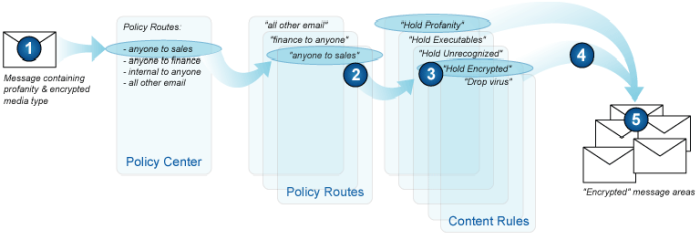How ARgon Server processes messages
- If the policy outcome for an incoming message is 'deliver', Clearswift ARgon for Email typically sends the message to your internal mail server.
- If the policy outcome for an outgoing message is 'deliver', Clearswift ARgon for Email typically routes the message using DNS, or sends it on to your external mail server.
The following steps describe the processing of incoming mail.
- Clearswift ARgon for Email is contacted by an upstream mail server.
- Clearswift ARgon for Email invokes the policy defined in the first policy route listed on the Manage Policy Routes page whose mail route matches the message's "From" and "To" addresses.
- If the policy route has content rules applied, Clearswift ARgon for Email uses the "What to Look For?" clauses in each content rule to look for message conditions – such as the presence of a virus, spam, or media type. If a message matches all the "What to Look For?" clauses in a content rule, that rule is said to be triggered.
- Clearswift ARgon for Email performs the disposal action of the highest priority triggered content rule. If no content rules trigger, Clearswift ARgon for Email performs the policy route's default disposal action. The disposal action can be one of deliver, hold, drop (delete), non-deliver, or relay to a server.
- Clearswift ARgon for Email also performs any additional "What to Do?" actions specified in all triggered content rules, unless an action specifies otherwise. (With some actions you can specify that they should be performed only if the associated content rule's disposal action is performed, for example.) Additional actions might involve generating a notification message, annotating the message, and so on.
- If a deliver disposal action is performed, , Clearswift ARgon for Email places the message on the 'Ready for Dispatch' queue, where it awaits transmission to the appropriate downstream mail relay (typically, for incoming messages, your mail server).

This example assumes that the message is incoming, and that it has already been allowed through the Clearswift
|